At its core, ceramics consists simply of dirt that is mixed with water and shaped by the human hand. With a mastery of technique, however, artists can transform clay into works of art that are both structurally innovative and thought-provoking. The 2008 Taiwan Ceramics Biennale (臺灣國際陶藝雙年展), which opened on June 26 and runs until Dec. 7 at the Yingge Ceramics Museum (臺北縣立鶯歌陶瓷博物館), pays tribute to the ability of artists to create art from one of the most basic and elemental mediums.
This year marks the third time the Biennale, which was founded in 2004, brings together ceramics artists and scholars from around the world. Artists from 58 countries entered 684 ceramic pieces into this year’s competition. From that number, 114 works from 24 countries were selected for the exhibit, and 19 artists were honored with awards at a ceremony last Friday.
Taiwanese ceramics artist Chu Fang-yi’s (朱芳毅) piece Memory, Sign and Record of Objects (物件記憶•記號•紀錄) is this year’s recipient of the Taiwan Ceramics Award Grand Prize (台灣陶藝獎). The work consists of 25 black-and-white ceramic objects arranged in neat, orderly rows on a wall. The inspiration for the ceramic objects, which vaguely resemble familiar household wares like pots or teacups, represent Chu’s own experiences, but he kept the pieces simple and abstract to encourage viewers to develop their own interpretations.
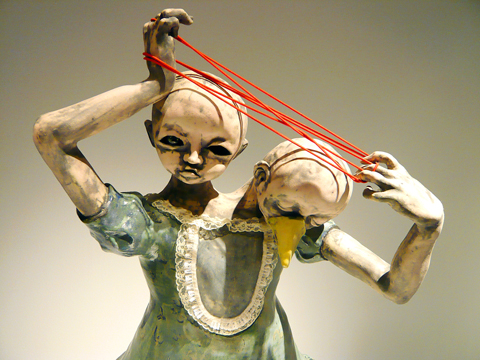
PHOTO: CATHERINE SHU, TAIPEI TIMES
The work was also inspired by Chu’s interest in ancient Chinese pictograph writing, and oracle bone script in particular.
“When modern-day people see these images and objects, they can still attempt to decode it and glean their own meaning from it, or discuss their interpretation with other people, so that it becomes a channel for communication,” says Chu. “That is something that I wanted to incorporate into my work.”
Chu, who studied ceramic art at Tainan National University of the Arts (國立臺南藝術大學) and participated in the Biennale for the first time this year, says that one of the attractions of ceramics as a medium is the unique tactile experience it offers.
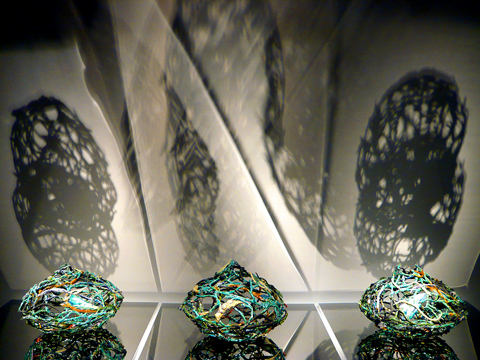
PHOTO: CATHERINE SHU, TAIPEI TIMES
“When I began studying ceramic arts, I really liked the feeling of the clay in my hands,” says Chu, “It felt very comfortable, and working with clay means that you get to have a very immediate, intimate contact with your work.”
The Biennale exhibit is grouped into four sections, each focusing on different themes in the artists’ work.
Vessels, Decoration, Conveyance highlights the creativity and diversity of pieces created in the shape of a vessel, one of the most basic ceramic forms, while Form, Space, Void and Substance focuses on more abstract pieces. Figures, Life, Concern gathers together representations of the human body, and Objects, Assemblies, Installations presents installations that consist of multiple ceramic pieces, including Chu’s Memory, Sign and Record of Objects.
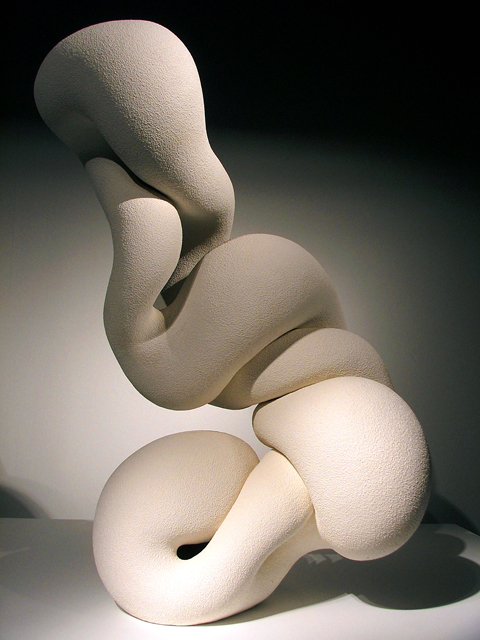
PHOTO: CATHERINE SHU, TAIPEI TIMES
Finalist Eric Nathan Landon, an American artist who has lived and worked in Denmark for the last nine years, entered his wall installation, Mimic, into the Taiwan Ceramics Biennale after seeing a poster for the event at the Danish School of Design. Mimic, which is made up of more than 500 wheel-thrown vessel-shaped objects that resemble mouths, is meant to be a commentary on “our culture of self-obsession” where, for example, individuals seem much more invested in editing their MySpace profiles than in creating a sense of community with the people around them, says Landon.
Landon says that he enjoyed learning more about Taiwanese ceramic art.
“In Danish institutions, students are encouraged to work to a goal, and to not try too many things,” says Landon, “Based on what I’ve seen, experimentation is really alive here.”
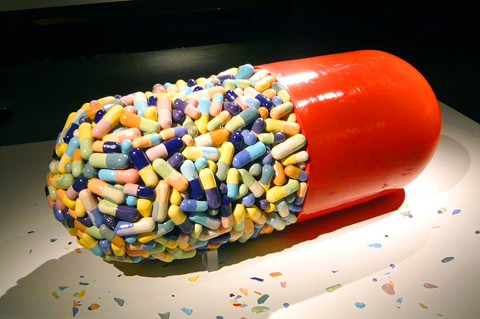
PHOTO: CATHERINE SHU, TAIPEI TIMES
Other works to watch out for at the Biennale include South Korean artist Lee Chun-bok’s Gold prize winner Hidden Space, a porcelain piece whose airiness, simplicity and graceful curves belies Chun’s technical mastery, and Without Title by Dutch artist Paula Bastiaansen, which resembles an unfurling nautilus shell. Spainard Xavier Monsalvatje’s Pulse, Press is a ironic pastiche of a Ming vase where a figure in a gas mask replaces traditional motifs, while Double Basin by American Jennifer Woodin calls attention to the quotidian elegance of the humble plumbing fixture.
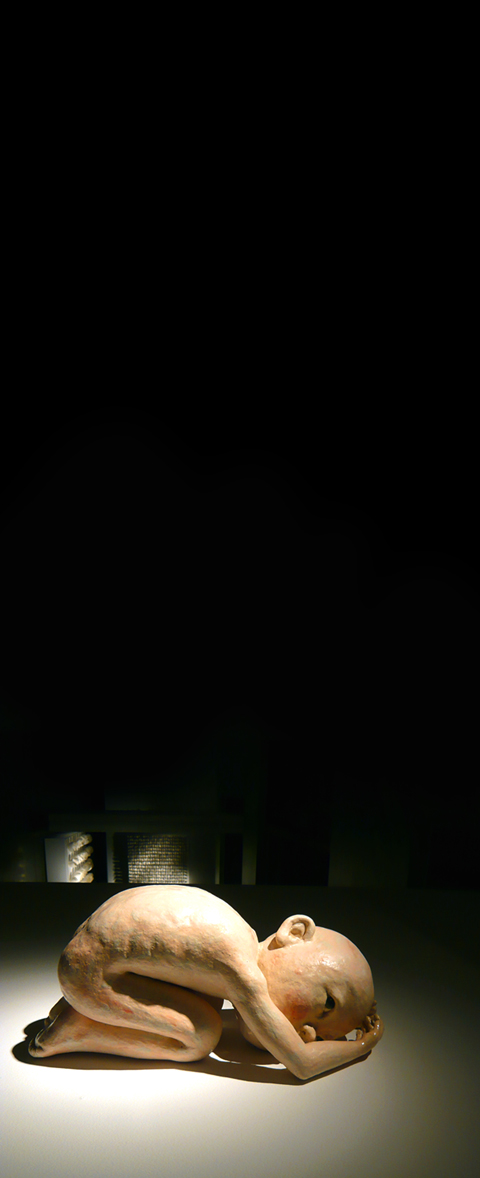
PHOTO: CATHERINE SHU, TAIPEI TIMES

Aug. 4 to Aug. 10 When Coca-Cola finally pushed its way into Taiwan’s market in 1968, it allegedly vowed to wipe out its major domestic rival Hey Song within five years. But Hey Song, which began as a manual operation in a family cow shed in 1925, had proven its resilience, surviving numerous setbacks — including the loss of autonomy and nearly all its assets due to the Japanese colonial government’s wartime economic policy. By the 1960s, Hey Song had risen to the top of Taiwan’s beverage industry. This success was driven not only by president Chang Wen-chi’s

Last week, on the heels of the recall election that turned out so badly for Taiwan, came the news that US President Donald Trump had blocked the transit of President William Lai (賴清德) through the US on his way to Latin America. A few days later the international media reported that in June a scheduled visit by Minister of National Defense Wellington Koo (顧立雄) for high level meetings was canceled by the US after China’s President Xi Jinping (習近平) asked Trump to curb US engagement with Taiwan during a June phone call. The cancellation of Lai’s transit was a gaudy

From Godzilla’s fiery atomic breath to post-apocalyptic anime and harrowing depictions of radiation sickness, the influence of the nuclear bombings of Hiroshima and Nagasaki runs deep in Japanese popular culture. In the 80 years since the World War II attacks, stories of destruction and mutation have been fused with fears around natural disasters and, more recently, the Fukushima crisis. Classic manga and anime series Astro Boy is called “Mighty Atom” in Japanese, while city-leveling explosions loom large in other titles such as Akira, Neon Genesis Evangelion and Attack on Titan. “Living through tremendous pain” and overcoming trauma is a recurrent theme in Japan’s

As last month dawned, the Democratic Progressive Party (DPP) was in a good position. The recall campaigns had strong momentum, polling showed many Chinese Nationalist Party (KMT) lawmakers at risk of recall and even the KMT was bracing for losing seats while facing a tsunami of voter fraud investigations. Polling pointed to some of the recalls being a lock for victory. Though in most districts the majority was against recalling their lawmaker, among voters “definitely” planning to vote, there were double-digit margins in favor of recall in at least five districts, with three districts near or above 20 percent in